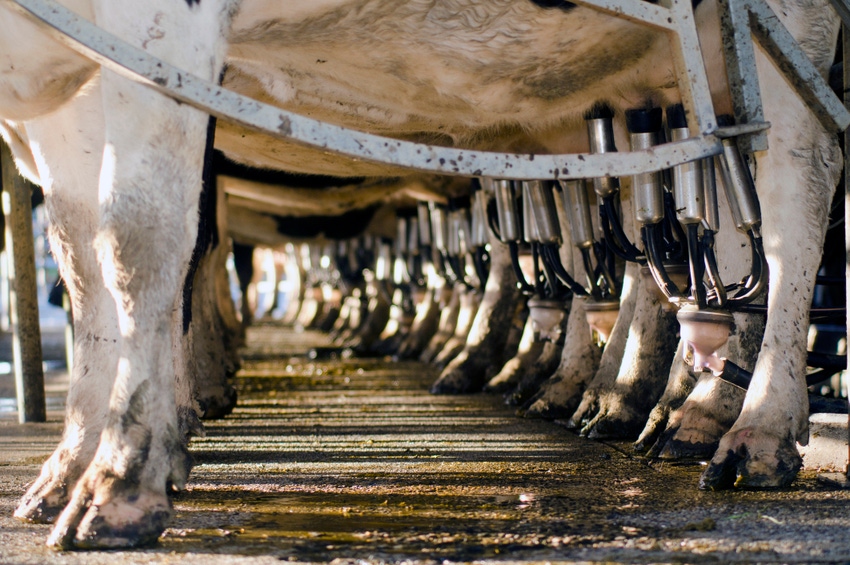Multi-institution research project in U.K. to study claw horn disruption lesions, while Kentucky researchers develop economic model for lameness prevention.

A new study in the U.K. plans to shed light on the causes of lameness and reduced mobility in dairy cows. The project will be a collaborative effort among the Royal Veterinary College (RVC) of the University of London, Scottish Rural College (SRUC) and theUniversity of Liverpool.
SRUC professor Georgios Banos, who is heading up the project, described lameness as “one of the most serious and debilitating cow conditions our dairy farmers have to face."
Banos added, “In addition to pain and discomfort to the animal, lameness is associated with decreased milk production and inflated farm costs. Among cows raised in the same environment, some become lame, while others do not. Understanding the reasons behind this will help us develop targeted preventive practices, contributing to enhanced animal welfare and farm profitability.”
Researchers from these institutions will focus particularly on improving the understanding of factors that cause claw horn disruption lesions (CHDL) in dairy cattle, which has never been studied in such depth before, the RVC announcement said, adding that CHDL is the most prevalent condition behind impaired mobility and related pain in dairy cows both globally and across the U.K. The project has the potential to considerably improve animal health and welfare through the development of efficient management practices, new breeding tools and novel pharmaceutical interventions, RVC said.
According to RVC, the study will involve closely monitoring and recording relevant data on pregnant dairy cows from 60 days before calving to the first half of lactation. It will also investigate genetic resistance to CHDL by genetically profiling individual animals and performing advanced genomic and functional genomic analyses. Finally, optimal breeding strategies will be developed with the aim of providing the means to breed cattle that are genetically resistant to lameness.
Experts in the the fields of animal science, veterinary medicine, genetics, biotechnology, bioinformatics, molecular pathology, immunology, microscopy and epidemiology will be drawn upon to carry out this work.
Commenting on the project, Dr. Androniki Psifidi, RVC lecturer in veterinary clinical genetics, said, “For the first time, cutting-edge technologies will be applied to develop new tools to control this important animal health and welfare issue. We are very enthusiastic about this project and anticipate that it will make a big difference for both the animals and the sustainability of the sector.”
RVC professor of molecular immunology Dirk Werling added, “Globally, lameness is the second-biggest welfare problem observed in production dairy cattle. However, we have, as yet, a very limited understanding as to why the immune system is not capable of clearing the infection. Combining all the different approaches within one project, thus, provides a very unique opportunity to [have an] impact on animal welfare.”
Dr. Dong Xia, RVC lecturer in bioinformatics, said, “This exciting multidisciplinary collaboration will generate a comprehensive understanding of the molecular mechanisms controlling foot health of dairy cattle.”
Funding for the £1 million project, which is scheduled to run for three years, comes from the U.K.'s Biotechnology & Biological Sciences Research Council. The initial stage of identifying and gaining permission from farms raising the animals has already been completed.
Economics of prevention
Indeed, lameness, a clinical condition often associated with a variety of different foot disorders, is considered one of the most important animal welfare issues in the dairy industry today and is estimated to be one of the most expensive dairy diseases per case, according to a recent article published in the Journal of Dairy Science by K.A. Dolecheck of the University of Kentucky department of animal and food sciences, M.W. Overton with Elanco Animal Health, T.B. Mark with the University of Kentucky department of agricultural economics and J.M. Bewley with Alltech Inc.
In North American herds, Dolecheck et al. said reported lameness prevalence ranged from 10% to 55% between 2012 and 2016.
Many foot disorder prevention strategies are available to reduce lameness prevalence in dairy herds, including footbaths and preventive hoof trimming, the researchers wrote. However, they pointed out that a recent survey of 184 U.S. dairies indicated that producers are not consistently using recommended foot disorder prevention and control strategies.
Dolecheck et al. conducted a study using an existing farm-level stochastic simulation model to estimate the return on foot disorder prevention investment. If successful, the model could be used as a decision-making support tool to help calculate the amount a specific producer should be willing to spend on prevention, given the expected returns (reduced foot disorder losses).
They tested two potential strategies for foot disorder prevention: strategy 1 was prevention focused on reducing infectious foot disorders (e.g., digital dermatitis) in the model, and strategy 2 was prevention focused on reducing non-infectious foot disorders (e.g., sole ulcer and white line disease) in the model.
According to Dolecheck et al., the return on investment for foot disorder prevention would depend on the cost of the prevention strategy and the other benefits associated with the selected prevention strategy, but they noted that their model could be used as a decision-making support tool to help identify the amount that could be paid to implement a selected prevention strategy.
About the Author(s)
You May Also Like



